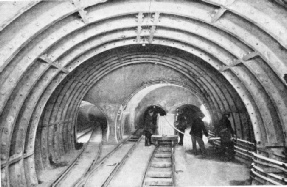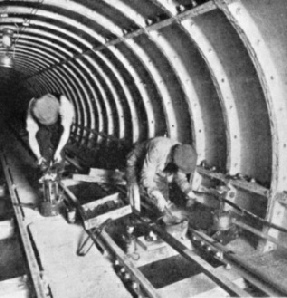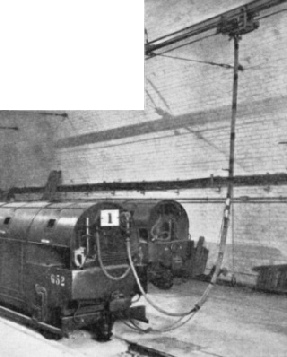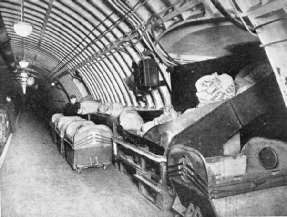

The Post Office Railway
Carrying Mails Eighty Feet Below London Streets

MOUNT PLEASANT JUNCTION on the Post Office Tube Railway. The miniature trains can shift nearly 30,000 mail bags a day. Each station is provided with lifts and spiral chutes, while many have moving conveyors and elevators to deal with the mail.
ONE of the most interesting railways in the world runs below Central London, carries no passengers, is worked without drivers, conductors or signals, and its existence is unknown to the majority of Londoners. This line is the Post Office Tube between Paddington and Whitechapel, which was built with the object of speeding up the distribution of letters and parcels between the railway termini and the principal district post offices on the route, simplifying the sorting office organization and giving a more regular and frequent service than would be possible with road transport.
As long ago as 1862 there was already in operation a species of miniature tube built by the Pneumatic Conveyance Company for the carriage of mail-
The railway, which is six and a half miles in length, and of which the original cost was about a million and a half pounds, was begun in 1914, but construction was stopped during the war, when the completed tunnels were used to store national art treasures away from the dangers of air raids. Work was further delayed by the coal stoppage of 1926, among other causes, and the line was not opened for traffic until December, 1927. There are eight stations, and, as will be seen from the accompanying map, the line follows closely the route of the eastern section of the Central London Railway, save for the detour necessary to serve Mount Pleasant, where the headquarters of the system are situated.
The method of construction follows the general lines of standard tube railway practice, save in the matter of dimensions. The gauge is only 2 ft, and while the stations themselves are roomy, the main tunnels, which carry both east-
These dimensions are, however, larger than they appear, since the standard diameter of the London tube railways (carrying a single track) is no more than 11 ft 8¼ in (save for the Great Northern and City, which was built with the idea of accommodating main-
The east-

LOADING A TRAIN with containers carrying the mail-
When the railway was first opened operation was by two-
The present vehicles, of which there are fifty, have a carrying capacity of more than twice as much as their predecessors -
The operating methods of this railway are unique. Control is exercised by the signalmen, whose cabins are fitted with illuminated track diagrams similar to those used on the London Underground Railways, on which the trains automatically indicate their movements within the section controlled by each box. Signalling in the ordinary sense does not exist; instead, the line is divided into short sections, and the passage of a train automatically cuts off the current from the length of track it has just traversed, which remains “dead” until the next section has been reached. Starting and stopping is effected by switching the current on and off.
To receive a train the signalman sets the power-
The stations are approached by up gradients, following the practice adopted on the Central London Railway, and on part of the City and South London’s Morden Extension. The incline is 1 in 20, and the combined effect of this gradient and the de-
Communication between the platform staff and the signalman is by a plunger device. In effect, the loaders notify the control cabin that the train is ready to start, and the signalman energizes the track.
Station indicators are provided at all the platforms, and the staff is thus notified whether a train is stopping at all stations or only at selected points en route, and whether or not it is making the end-
The stations are constructed in two tiers, the relays (of which there are over a thousand), switchgear, and other electrical equipment being housed in long galleries beneath the platforms. A remarkable engineering feature is that the point motors, instead of being at track level, are in certain instances, as at Mount Pleasant, situated in these lower galleries, this arrangement having been adopted on account of space restrictions.
30,000 Mail Bags Daily
Current can in emergency be switched off any section from the control cabin, and if it is necessary to cut off the energy from the whole of the section controlled from a box, the operation is effected by two king levers. There is also an emergency platform control, which enables a three-
The average daily traffic requires the handling of about 30,000 bags of mail matter. The end-
Each car has four containers, accommodating a total load of sixty bags of letter mail or twenty-
A system of lifts and spiral chutes, in which mail matter for east-

THE CAR DEPOT AT MOUNT PLEASANT, with extensive sidings for carrying out repairs and any overhaul that may be necessary. Mount Pleasant also has a “running round loop line” and an intricate system of tunnelling.
At Liverpool Street and Paddington, where the London and North Eastern and Great Western Railways respectively deal with large quantities of foreign in addition to inland mails, there is also an elaborate system for conveying the mail matter between the railway termini and the Post Office Tube stations.
This is effected through apertures in the platforms of the main-
Paddington also provides a typical example of the reversing loop layout, to which reference has already been made. The loop here is of special value, as the station is the western terminus of the tube railway, and trains can also be reversed by Y-
The problem of making further extensions has not been overlooked, for this complete tube railway scheme provides for possible future additions that would more than double the existing route mileage of the system. These extensions would take the line both north and south. The northern additions have been planned to radiate from Mount Pleasant, one line reaching to the Northern District Post Office, and the other serving Euston, St. Pancras, and King’s Cross Stations. The southern project calls for a line leaving the existing railway at King Edward Building (the General Post Office), running thence to Cannon Street, burrowing beneath the Thames, serving London Bridge and Waterloo Stations, running westwards from Waterloo to a point near Victoria Station, then travelling northwards until it links up with the Western Central District Office off New Oxford Street

CABLE LAYING. Owing to the small-
All these plans, although in abeyance at the time of writing, have not definitely been abandoned. In the meantime, road mail vans running over the projected routes feed the tube. It would be difficult to estimate the ultimate advantages accruing from the completion of the scheme, but they can be gauged from the fact that when the railway was opened, the immediate effect was to reduce the time of transit to between a third and a quarter of that taken by the mail vans, while it was calculated that rather over a quarter of the road vehicles in use in the area served would no longer be required.
Apart from greater speed and regularity, taking the traffic beneath the surface has also played an important part in lessening highway congestion. Owing to the crowded roads in Central London the motor mail vans are delayed, but the tube is independent of traffic blocks. Postal matter can therefore be carried by tube continuously and without delay between the termini.

PAPER INSULATION was used for the power cables which were also lead covered and wire armoured. This illustration shows the work in progress.
Except for week-
Practically the whole equipment of the system is in duplicate, a necessary precaution on a line where even a slight service interruption might have serious and cumulative consequences. There is an elaborate system of intercommunication telephones, and, following standard passenger tube railway practice, the tunnels are equipped with bare telephone wires, to which a portable instrument can be clipped for use in case of breakdown or emergency.

SAFETY FIRST. So that there shall be no live rails in the depot, a train is moved by attaching to the power vehicle a flexible electric coupler connected to a collector trolley. This runs on a system of steel joists suspended from the roof of the depot, thus avoiding danger. Wagons are shunted by press-
In addition to having the largest station, Mount Pleasant also houses the car sheds. These are situated at a slightly higher level than the running lines, to which access is by a 1 in 20 incline. Entry of the vehicles to the station at safe speeds is ensured by an electrically operated cam-
The depot is equipped for the overhaul and repair of the rolling-
A circular vertical shaft is situated at one end of the depot, the purpose of which is to admit the entrance of new rolling-
A typical example of the conveyers used is at Liverpool Street, where traffic is interchanged with the London and North Eastern Railway terminus. Two parcel conveyers, 315 ft long, running at 180 ft a minute, and with a load capacity of a ton and a half, connect the No. 10 and No. 11 main line platforms with the tube.
The mail bags are handled through platform hatches, as at Paddington, but double-
The speed of the conveyers at the different stations varies considerably, ranging down to a minimum of 30 ft a minute. Each is driven by its separate motor, and starting and stopping are by push-

BATTERY-
The Post Office Tube has been described as being “perhaps the best example of a robot railway in the world”, but the description requires qualification. It is a robot system in the sense that there are no signals and that its trains are driverless and automatically “keep station”, but, as we have seen, this method of working has largely been made possible by transferring the control of train movements from driver to signalman. (Switchman would really be the better word.) This official is, however, reinforced by automatic electrical devices.
The line is track-
The automatic sections are normally “live”, while the braking sections and those within the station are “dead”. Clearing a section temporarily cuts off the track current, which is again automatically restored with the further progress of the train. On arrival at the braking section, which is “dead” and is situated on a rising gradient of 1 in 20 to ensure further retardation, the train first comes to a stop, and is then automatically re-

IN SERVICE. This is the type of wagon used on the GPO subway. The carriage frame in which the mail containers are stowed is carried on two maximum-
A possible contingency with this method of control is that in the event of a mechanical defect that reduces the speed of the train, the period of application of the 440-
A converse operation prevents the train from running into the station at too high a speed. Therefore we may say that no other railway approaches so near the robot.

LOADING CONTAINERS FROM A CONVEYER. The mail bags are made up in the Sorting Offices and passed down the conveyers to the underground stations. Here, on the platform, the bags are placed into the containers read to be wheeled into the trains.
You can read more on
“Chicago’s Unique Underground”,
“Underground and Overhead Lines” and
on this website.